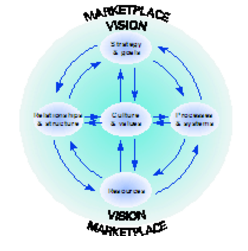BPI Technique - Organizational System Model - OSM
Description
- Structured approach for describing how an organization operates as a systemic whole. It can be used both for the current analysis, and the future modeling, of an organization.
When to Use
- The model can be used in several ways:
- Selling tool for BPI engagements - The model can create a positive impact during the selling phase. It is a relatively easy model to understand and demonstrates that the we understand the complexity of the issues associated with a major change such as BPI.
- Means to create a common language with the client about the change agenda
- The model can be used during the Awaken and Envision phases as a way of developing a common language of concepts and images that sum up in a powerful way the critical challenges confronting the BPI initiative.
- A framework for developing an Internal Organizational Overview, Holistic Business Model. (since the model is an inclusive model that covers all key elements of an organization).
Approach
This technique facilitates the development of a high-level overview of what an organization is like currently, and what it aspires to be like in the future. By comparing and contrasting the current and the future overviews, some of the key change issues are highlighted.
One of the particular values of the technique is that it focuses not only on the component elements of an organization, but also on the interdependencies between different elements. This allows an organisation to see :
- particular weaknesses in one or more of the elements (e.g. core competencies are not defined; corporate performance indicators lack a customer focus); and
- poor relationships between different elements (e.g. reward systems that discourage the adoption of corporate values, such as team work; limited delegations that lead to the disempowerment of customer-service employees).
Here are typical steps for effectively using this technique.
- Present the model to the joint project team, and describe how it works.
- Agree on a process for using the model either to:
- Collect information about the current organization, (see Internal Organizational Overview); or
- Develop ideas about the desired future organization
- Agree on topics for data collection, or idea generation, under each element within the model.
- Marketplace - competitors, customers, industry regulators, lobby groups, etc.
- Vision - fundamental business purpose and business position
- Strategy and goals - strategic plan, business plan and performance measures
- Processes and systems - technology, process design, decision-making and control systems
- Relationships and structure - accountability framework, customer relationships, and supplier/vendor relationships
- Resources - core competencies, human resources, finance, and physical facilities
- Culture and values - leadership/management style, shared beliefs, and norms and values
- Implement data-collection and/or idea-generation processes.
- Summarize and present findings.
Guidelines
Problems/Solutions
- There may be debate about where, within the model, should a particular feature of the organization be located. Emphasize that it is more important to capture the feature (as opposed to omitting it) than it is to find the perfect placement for it. Therefore, choose any appropriate spot, and remain open to ideas from the organisation about alternative placement. The process of dialogue that will result from this can generate valuable insights into the internal dynamics of the client.
- An interesting debate may occur about whether culture and values are the result of the other elements, or vice versa. Allow this debate to occur, because it will eventually help to focus attention on the need for a co-ordinated approach to change.
Tactics/Helpful Hints
- Stress that the most important feature is the arrows. These indicate the interdependencies of various elements. The use of the model often highlights mismatches or disconnects between one part of the organization and another.
- Stress that the arrows represent a web of interdependency, not a hierarchy. Indeed, hierarchically lower-order elements can undermine the power or success of higher-order ones (e.g. untrained staff can cause an excellent business strategy, which has Board support, to fail).
Resources/Timing
- Introduce this model into the project at an early stage. It then becomes part of the common language of the project team, and begins the process of helping them to see the organization as a dynamic system.


No comments :
Post a Comment